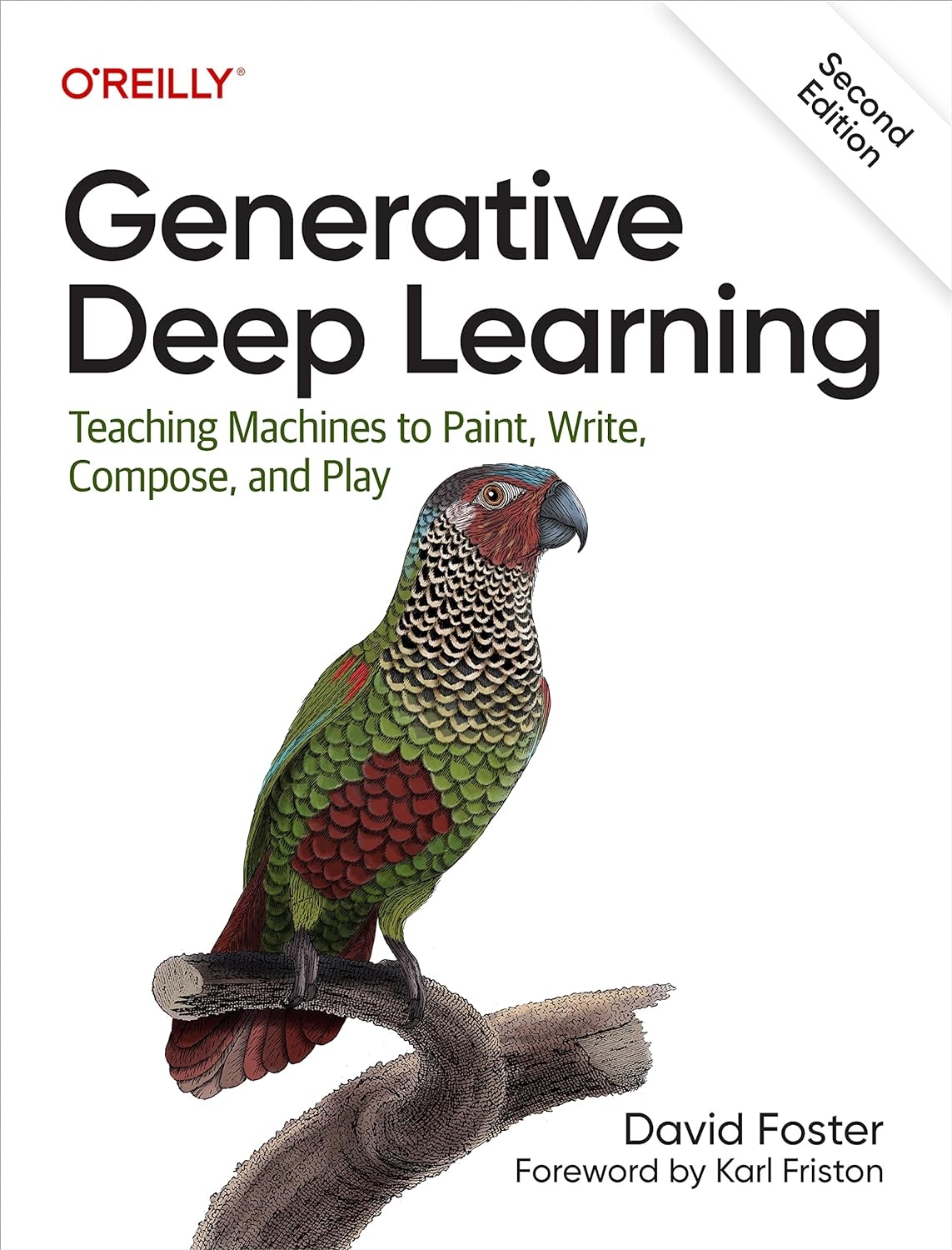Description
From the brand
From the Publisher

From the Preface
Objective and Approach
This book assumes no prior knowledge of generative AI. We will build up all of the key concepts from scratch in a way that is intuitive and easy to follow, so don’t worry if you have no experience with generative AI. You have come to the right place!
Rather than only covering the techniques that are currently in vogue, this book serves as a complete guide to generative modeling that covers a broad range of model families. There is no one technique that is objectively better or worse than any other—in fact, many state-of-the-art models now mix together ideas from across the broad spectrum of approaches to generative modeling. For this reason, it is important to keep abreast of developments across all areas of generative AI, rather than focusing on one particular kind of technique. One thing is certain: the field of generative AI is moving fast, and you never know where the next groundbreaking idea will come from!
With this in mind, the approach I will take is to show you how to train your own generative models on your own data, rather than relying on pre-trained off-the-shelf models. While there are now many impressive open source generative models that can be downloaded and run in a few lines of code, the aim of this book is to dig deeper into their architecture and design from first principles, so that you gain a complete understanding of how they work and can code up examples of each technique from scratch using Python and Keras.
In summary, this book can be thought of as a map of the current generative AI landscape that covers both theory and practical applications, including full working examples of key models from the literature. We will walk through the code for each step by step, with clear signposts that show how the code implements the theory underpinning each technique. This book can be read cover to cover or used as a reference book that you can dip into. Above all, I hope you find it a useful and enjoyable read!
Prerequisites
This book assumes that you have experience coding in Python. If you are not familiar with Python, the best place to start is through LearnPython.org. There are many free resources online that will allow you to develop enough Python knowledge to work with the examples in this book.
Also, since some of the models are described using mathematical notation, it will be useful to have a solid understanding of linear algebra (for example, matrix multiplication) and general probability theory. A useful resource is Deisenroth et al.’s book Mathematics for Machine Learning (Cambridge University Press), which is freely available.
The book assumes no prior knowledge of generative modeling (we will examine the key concepts in Chapter 1) or TensorFlow and Keras (these libraries will be introduced in Chapter 2).
Editorial Reviews
Review
Head of Strategy, Stability AI
This book is becoming part of my life. On finding a copy in my living room I asked my son: “when did you get this?”. He replied, “when you gave it to me”, bemused by my senior moment. Going through various sections together, I came to regard Generative Deep Learning as the ‘Gray’s Anatomy’ of Generative AI.
The author dissects the anatomy of Generative AI with an incredible clarity and reassuring authority. He offers a truly remarkable account of a fast-moving field, underwritten with pragmatic examples, engaging narratives and references that are so current, it reads like a living history.
Throughout his deconstructions, the author maintains a sense of wonder and excitement about the potential of Generative AI – especially evident in the book’s compelling dénouement: having laid bare the technology, the author reminds us that we are at the dawn of a new age of intelligence. An age in which Generative AI holds a mirror up to our language, our art, our creativity; reflecting not just what we have created, but what we could create — what we can create — limited only by “your own imagination”.
The central theme of generative models in artificial intelligence resonates deeply with me, because I see exactly the same themes emerging in the natural sciences; namely, a view of ourselves as generative models of our lived world. I suspect – in the next edition of this book — we will read about the confluence of artificial and natural intelligence. Until that time, I will keep this edition next to my Gray’s Anatomy, and other treasures on my bookshelf.
Karl Friston, FRSProfessor of Neuroscience, University College London.
Generative AI is reshaping countless industries and powering a new generation of creative tools. This book is the perfect way to get going with generative modeling and start building with this revolutionary technology yourself.
Ed Newton-RexVP Audio at Stability AI and composer
An excellent book that dives right into all of the major techniques behind state-of-the-art generative deep learning. You’ll find intuitive explanations and clever analogies — backed by didactic, highly readable code examples. An exciting exploration of one of the most fascinating domains in AI!
Generative AI is the next revolutionary step in AI technology that will have a massive impact on the world. This book provides a great introduction to this field and its incredible potential and potential risks.
About the Author
Through ADSP, David leads the delivery of high-profile data science and AI projects across the public and private sectors. He has won several international machine-learning competitions and is a faculty member of the Machine Learning Institute. He has given talks internationally on topics related to the application of cutting-edge data science and AI within industry and academia.





anzelix –
Awesome book and great codebase. A reference for modern AI.
Purev-Oidov. G. –
Hello fellas, I ordered a generative deep learning book from an another source, but had poor quality as well as poor content. But this book is focused on an important part of generative deep learning also has a good quality of content. Really appreciate that I bought this book.
Yalin –
This is a lovely book. It is readable and explains the principles behind algorithms clearly.
tech savvy –
The book is in very good condition, but it has stick notes in it! I seriously doubt they are from the author….
Robert –
Amazing book, for me the best thing about it is that there are many well-sourced and working code and data examples which are explained clearly in the text.
Anonymous –
I haven’t finished yet, but it’s been helpful to implement the examples. So far it’s been a great learning resource.
Pen Name –
This book is an invaluable resource for anyone interested in delving into the fascinating world of generative artificial intelligence. With its clear writing, engaging style, and practical examples, it’s sure to inspire and inform readers on their journey to mastering this cutting-edge technology.Pros:- Excellent structure and easy to follow- Code examples are maintained and work seamlessly- Great balance between theory and practicumCons:- Some of the models did not produce the same results as the book’s after training (training did not go well), however, it’s understandable as these are models that are notoriously hard to train.Overall: highly recommended!
Zack Thoutt –
When I first started learning how to train generative models, I tried taking online courses, but even the expensive ones from top providers never went deep enough into either the math or the code to truly equip me to engineer novel solutions with this technology—at best I could imitate cookie-cutter solutions. Of all the technical books I’ve read on software, not just generative deep learning, this one has the clearest explanations and goes into every nitty-gritty detail.My first edition copy of Generative Deep Learning has been scribbled in, dog-eared, and beaten up over the course of the last few years. Now that I have my second edition, the first will finally get some much-deserved rest on my bookshelf. Technology has evolved quickly and the second edition covers everything I’ve come across in the field more recently that hadn’t been invented yet when the first edition was released.I’ve invested a lot in educating myself on machine learning over the past eight years and Generative Deep Learning is by far the best value. I’d recommend it to people of any skill level, as the author does a great job explaining the beginner concepts, but also dives into more advanced topics and analysis than I’ve seen elsewhere.
Christian –
This review is for the Kindle edition. I have the 2nd print edition of the book and it looks like the 3rd edition has some good additions but rushed out. In this day and age of spell-checkers, auto-complete, and now generative AI, it is unacceptable that the electronic version has poor quality.Subscripts and other type settings are skipped in many places making it harder to read equations.For example J = dz 1 dx 1… or det abcd = ad bc. For some reason many kindle books are plagued with some symbol getting substituted with a square []. You have to guess what that symbol was supposed to be. For the price, that shouldn’t happen.The irony is this a book about generative AI which is supposed to simplify or at least help in such things. If you can wait, maybe there will be a revised edition.
itsokjanet –
I was very excited to read this book on a kindle during long travels. The content, as far I was able to read, was very well put with examples building up the complexity gradually.However, the equations and notations are represented completely unreadable in Kindle. I mean they are completely jibberish comparing to the same ebook on non-kindle devices. So if you plan to use your Kindle, just pass that option. Go for either pdf or the physical book. (I attached screenshots from the kindle version on a paperwhite and kindle on an iphone too demonstrate the difference).What’s not acceptable is that the publisher is still ok with selling the Kindle version. The examples with notations are the heart and soul of this book, and they are everywhere. They know they are completely unreadable, and still publish the horrible Kindle version. Look, if the book is horrible in kindle, just dont publish in that media. This is also damaging the author’s credibility, and it is a complete disrespect for author’s efforts and readers’ time and money.